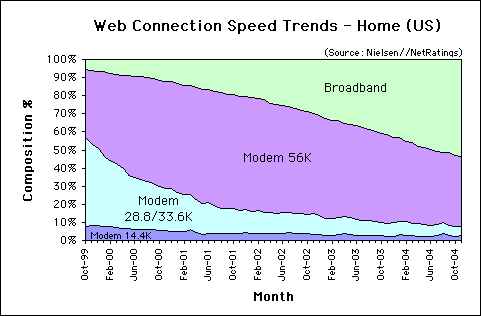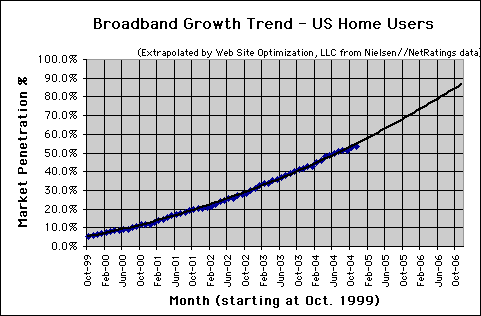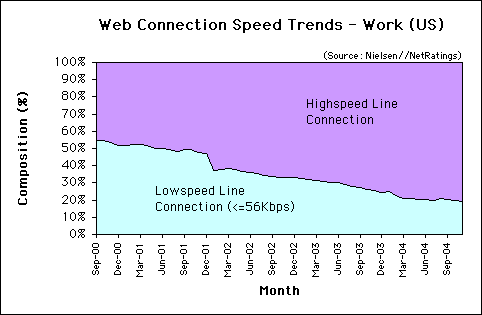The US is a generation behind Japan and Korea in high-speed broadband adoption, according to a recent report. U.S. broadband penetration grew by 0.73 percentage points to 53.59% among active Internet users in November. 46.41% of US home users dial into the Internet with “narrowband” connections of 56Kbps or less.
The charts below, derived from Nielsen//NetRatings data, show trends in connection speeds to the Internet for United States users.*
Home Connectivity in the US
In November 2004, most active Internet users connect from home with broadband connections. Among narrowband users, 38.70% use 56Kbps modems, 5.19% use 28/33.3Kbps, and 2.52% use 14.4Kbps modems. In total, 46.41% of home users in the US connect to the Internet at 56Kbps or less (see Figure 1).
Web Connection Speed Trends – Home Users (US)
Figure 1: Web Connection Speed Trends – Home Users (US)
Source: Nielsen//NetRatings
Broadband Growth in the US
Broadband penetration in the US grew by 0.73 points to 53.59% in November, up from 52.86% in October. This increase is lower than the average increase in broadband of 1.0 point per month over the previous twelve months. Broadband share in the US should exceed 70% by November of 2005 (see Figure 2).
Broadband Connection Speed Trend – Home Users (US)
Figure 2: Broadband Connection Speed Trend – Home Users (US)
Extrapolated from Nielsen//NetRatings data
Work Connectivity
Most workers in the US enjoy high-speed connections to the Internet. Most use a high-speed line such as a T1 connection, and share bandwidth between computers connected to an Ethernet network. The speed of each connection decreases as more employees hook up to the LAN. As of November of 2004, of those connected to the Internet, 80.9% of US users at work enjoy a high-speed connection, up 0.57 percentage points from 80.33% in October. 19.1% connect from work at 56Kbps or less (see Figure 3).
Web Connection Speed Trends – Work Users (US)
Figure 3: Web Connection Speed Trends – Work Users (US)
Source: Nielsen//NetRatings
U.S. a Generation Behind Japan and Korea in High-Speed Broadband
The U.S. is a generation behind higher speed nations in high-speed broadband adoption, according to a report by Technology Futures, Inc. While the U.S. languishes at 1 to 6MB/s, Japan and Korea are already rolling out next generation 20MB per second speeds.
Further Reading
- Forecasts for Higher Bandwidth Broadband Services
- Higher bandwidth applications, especially IP Video, will drive an increase in broadband data rates and penetration worldwide, forecasts Technology Futures, Inc. By 2006, U.S. broadband penetration will reach 50% and shift to higher data rates. By 2010, 75% broadband penetration is likely in the US, with 10% to 20% of households subscribing to very high speed broadband. Japan and Korea are already rolling out next generation 20Mb/s and above, while the U.S. is a generation behind in broadband data rates.
- In Canada, Broadband is Defined as Speeds in Excess of 64Kbps, a Lower Threshold Than in Other Countries
- In Canada, broadband is defined as speeds in excess of 64Kbps, a lower threshold than in other countries. This partially accounts for Canada’s high broadband penetration rate. Business Wire/TMCNet.com, Dec. 8, 2004
- Nielsen//NetRatings
- Provides the US broadband data (percentage of active Internet users) for the Bandwidth Report.
*Note that Nielsen//NetRatings reports the percentage of active Internet users that use broadband from home, not broadband households. NetRatings uses a panel of 40,000 to 50,000 people with software meters installed on their computers. These meters detect connection speeds. Each month they do an enumeration study to call a number of people to calibrate the panel by adjusting weightings to match the population at large.
The Bandwidth Report is featured monthly on URLwire – news of useful and unique web content since 1994.



